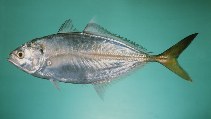Add your observation in Fish Watcher
| Native range | All suitable habitat | Point map | Year 2050 |

|
| This map was computer-generated and has not yet been reviewed. |
| Alepes djedaba AquaMaps Data sources: GBIF OBIS |
Upload your photos and videos
Pictures | Videos | Google imageAlepes djedaba
Picture by Randall, J.E.
Pictures | Videos | Google imageAlepes djedaba
Picture by Randall, J.E.
Israel country information
Common names:
Tarakhon, Tsninit du-yamit
Occurrence: introduced
Salinity: marine
Abundance: abundant (always seen in some numbers) | Ref: Walford, L. and R. Wicklund, 1973
Importance: commercial | Ref: Galil, B.S., 2007
Aquaculture: | Ref:
Regulations: | Ref:
Uses: no uses
Comments: A lessepsian migrant; (see Introduction Table). Large numbers caught occasionally with gill nets and light fishing (Ref. 6328). Recorded from Haifa Bay in 1924 (Ref. 72453). Also Ref. 93649.
National Checklist:
Country Information: https://www.cia.gov/library/publications/resources/the-world-factbook/geos/is.html
National Fisheries Authority:
Occurrences: Occurrences Point map
Main Ref: Por, F.D., 1978
National Database:
Occurrence: introduced
Salinity: marine
Abundance: abundant (always seen in some numbers) | Ref: Walford, L. and R. Wicklund, 1973
Importance: commercial | Ref: Galil, B.S., 2007
Aquaculture: | Ref:
Regulations: | Ref:
Uses: no uses
Comments: A lessepsian migrant; (see Introduction Table). Large numbers caught occasionally with gill nets and light fishing (Ref. 6328). Recorded from Haifa Bay in 1924 (Ref. 72453). Also Ref. 93649.
National Checklist:
Country Information: https://www.cia.gov/library/publications/resources/the-world-factbook/geos/is.html
National Fisheries Authority:
Occurrences: Occurrences Point map
Main Ref: Por, F.D., 1978
National Database:
Common names from other countries
Classification / Names Common names | Synonyms | Catalog of Fishes(genus, species) | ITIS | CoL | WoRMS | Cloffa
Teleostei (teleosts) > Carangiformes (Jacks) > Carangidae (Jacks and pompanos) > Caranginae
Etymology: Alepes: Greek, alepis, -idos = without scales (Ref. 45335).
Etymology: Alepes: Greek, alepis, -idos = without scales (Ref. 45335).
Environment: milieu / climate zone / depth range / distribution range Ecology
Marine; reef-associated; amphidromous (Ref. 51243). Subtropical; 46°N - 37°S, 19°E - 138°W
Distribution Countries | FAO areas | Ecosystems | Occurrences | Point map | Introductions | Faunafri
Indo-Pacific: Red Sea and East Africa (Ref. 12484) to the Hawaiian Islands, north to Japan, south to Australia. Immigrant to the eastern Mediterranean through the Suez Canal, wetward to Malta (Ref. 33971).
Length at first maturity / Size / Weight / Age
Maturity: Lm 16.3 range ? - ? cm
Max length : 40.0 cm TL male/unsexed; (Ref. 11228); common length : 25.0 cm FL male/unsexed; (Ref. 3397); max. published weight: 603.00 g (Ref. 128705)
Max length : 40.0 cm TL male/unsexed; (Ref. 11228); common length : 25.0 cm FL male/unsexed; (Ref. 3397); max. published weight: 603.00 g (Ref. 128705)
Short description Identification keys | Morphology | Morphometrics
Dorsal spines (total): 9; Dorsal soft rays (total): 22 - 25; Anal spines: 3; Anal soft rays: 18 - 20.
Adults form large schools near inshore reefs (Ref. 30573). Feed on shrimps, copepods, decapod larvae and other crustacean larvae and small fish (Ref. 5213, 90102). Eggs are pelagic (Ref. 4233). Often caught by ski-boat anglers in southern Africa (Ref. 12484).
Life cycle and mating behavior Maturity | Reproduction | Spawning | Eggs | Fecundity | Larvae
Main reference
Upload your references | References | Coordinator : Smith-Vaniz, William F. | Collaborators
Bauchot, M.-L., 1987. Poissons osseux. p. 891-1421. In W. Fischer, M.L. Bauchot and M. Schneider (eds.) Fiches FAO d'identification pour les besoins de la pêche. (rev. 1). Méditerranée et mer Noire. Zone de pêche 37. Vol. II. Commission des Communautés Européennes and FAO, Rome. (Ref. 3397)
IUCN Red List Status (Ref. 130435: Version 2024-2)
Least Concern (LC) ; Date assessed: 06 March 2015
Threat to humans
Harmless
Human uses
Fisheries: commercial; gamefish: yes
FAO(Fisheries: production; publication : search) | FishSource | Sea Around Us
More information
Population dynamics
Growth parameters
Max. ages / sizes
Length-weight rel.
Length-length rel.
Length-frequencies
Mass conversion
Recruitment
Abundance
Growth parameters
Max. ages / sizes
Length-weight rel.
Length-length rel.
Length-frequencies
Mass conversion
Recruitment
Abundance
Physiology
Body composition
Nutrients
Oxygen consumption
Swimming type
Swimming speed
Visual pigments
Fish sound
Diseases & Parasites
Toxicity (LC50s)
Body composition
Nutrients
Oxygen consumption
Swimming type
Swimming speed
Visual pigments
Fish sound
Diseases & Parasites
Toxicity (LC50s)
Genetics
Genetics
Heterozygosity
Heritability
Genetics
Heterozygosity
Heritability
Human related
Aquaculture systems
Aquaculture profiles
Strains
Ciguatera cases
Stamps, coins, misc.
Aquaculture systems
Aquaculture profiles
Strains
Ciguatera cases
Stamps, coins, misc.
Tools
Bio-Quiz | E-book | Field guide | Identification keys | Length-frequency wizard | Life-history tool | Point map | Classification Tree
| Catch-MSY |
Special reports
Download XML
Internet sources
Alien/Invasive Species database | Aquatic Commons | BHL | Cloffa | BOLDSystems | Websites from users | Check FishWatcher | CISTI | Catalog of Fishes(genus, species) | DiscoverLife | ECOTOX | Faunafri | Fishtrace | GenBank(genome, nucleotide) | GloBI | GOBASE | | Google Books | Google Scholar | Google | IGFA World Record | MitoFish | National databases | Otolith Atlas of Taiwan Fishes | PubMed | Reef Life Survey | Scirus | SeaLifeBase | Tree of Life | Wikipedia(Go, Search) | World Records Freshwater Fishing | Zoological Record
Estimates based on models
Preferred temperature (Ref. 115969): 24.7 - 29, mean 28 (based on 1150 cells).
Phylogenetic diversity index (Ref. 82804): PD50 = 0.5312 [Uniqueness, from 0.5 = low to 2.0 = high].
Bayesian length-weight: a=0.01349 (0.01205 - 0.01510), b=2.96 (2.93 - 2.99), in cm Total Length, based on LWR estimates for this species (Ref. 93245).
Trophic level (Ref. 69278): 3.6 ±0.54 se; based on food items.
Resilience (Ref. 120179): High, minimum population doubling time less than 15 months (K>0.3).
Fishing Vulnerability (Ref. 59153): Low vulnerability (18 of 100).
Climate Vulnerability (Ref. 125649): Moderate vulnerability (42 of 100).




